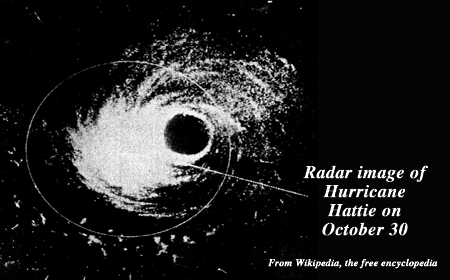The Saturday, October 28, 1961 issue of British Honduras’ leading newspaper, The Belize Billboard, reported that Hurricane Hattie had appeared in the Caribbean 550 miles southwest of Kingston, Jamaica, and 50 miles northwest of San Andres Island off Nicaragua. That same issue of the newspaper reported that 108 more British Hondurans had left for Florida, joining 109 of their brethren who had left earlier that week after being contracted to do farm work for the Florida Fruit and Vegetable Association.
On the following day, in the Sunday, October 29 issue of The Billboard, there was absolutely no mention of Hattie: that fatal storm had visibly begun heading north. On Tuesday night, approaching midnight, October 31, 1961, Category Five Hurricane Hattie, which had made an abrupt turn hard southwest, began destroying Belize, the capital of British Honduras; Stann Creek Town; and points in between.
In fact, and in retrospect, two other hurricanes had alarmed British Hondurans earlier that year. On Sunday, July 23, 1961, Hurricane Anna, which had threatened the entire B. H. coast, eventually moved south and struck Mango Creek and Placencia with 80 mile an hour winds. There were no human casualties. In early September, just seven weeks before Hattie, Hurricane Carla had moved northwards after threatening Belize. The mood in Belize towards Hattie, because of the two earlier threats, was almost blasé, until late the Tuesday morning of October 31, when all schoolchildren were sent home from primary and secondary schools.
The Billboard had reported in its Tuesday, August 1, 1961 issue that the United States Weather Bureau had announced plans to carry out experiments on hurricanes with the seeding of silver iodide crystals, scattered from above the storms by airplanes, before November 15. But in mid-September, the Bureau said it would start the process immediately by seeding Hurricane Esther.
In British Honduras, after Hurricane Hattie had changed course so drastically to come and destroy us, the speculation afterwards was that there must have been silver iodide seeding by the Americans which reversed the storm’s direction. Whatever the truth, the United States Consulate (no Embassy back then in colonial days) issued the sensational announcement after Hattie’s devastation that any destitute Belizean who had a relative or relatives in the United States would be allowed to migrate to America. Thus began the mass exodus of black Belizeans which would lead to the great changes in the demographics and flavor of British Honduras/Belize.

